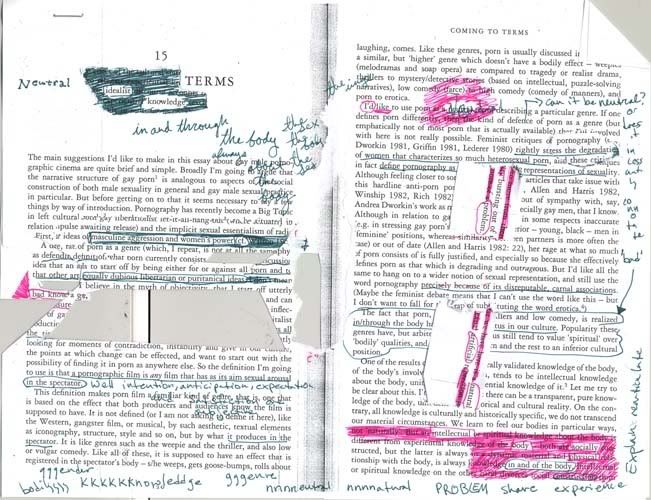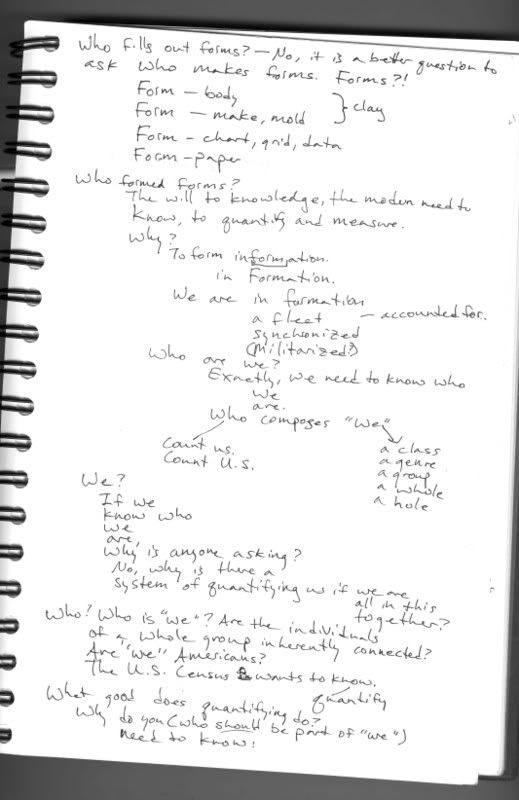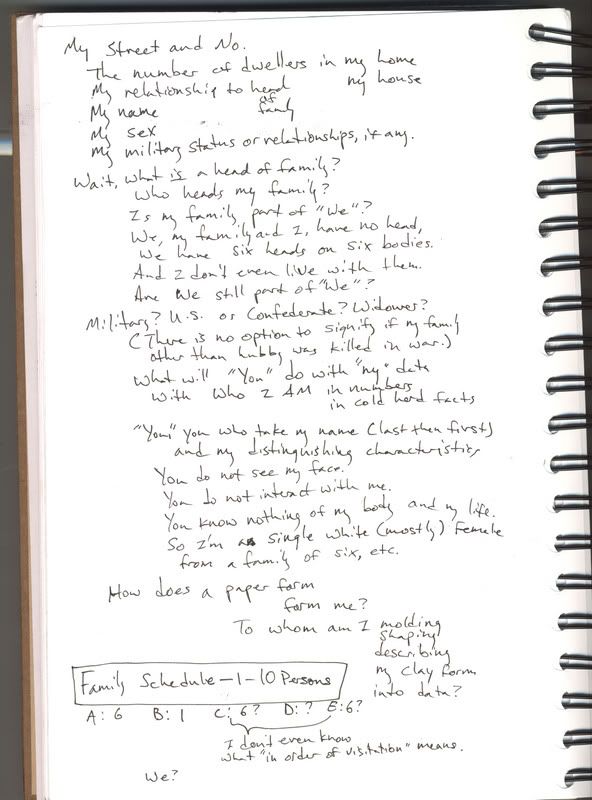
Fashioning the Body: Versions of the Citizen, the Self, and the Subject
The Evergreen State College | Fall 2007-Winter 2008
User Login |
Emily's blogObituary for an ObjectOn October 20th, 2007, the gold leaf pin passed away peacefully in her home. Her birthdate and hometown are unknown, but relatives believe gold leaf pin was from a large department store in Seattle, possibly from the 1950s. Gold leaf pin was shapely, poised, and had a twinkle in her diamond eye. Friends said she was friendly to all she encountered and lead a fine life. Her first partner was Laura Lee Robinson Holmes, a housewife and artist in the small town of Walla Walla, WA. Laura Lee often spent time with gold leaf pin, taking her to parties with the finest echelon of society. Gold leaf pin made many elegant and sophisticated acquaintances, never straying far from Laura Lee's shoulder. It wasn't until the early 1990s that Laura Lee passed away, leaving gold leaf pin in the guardianship of her son, John Holmes. John never wore the pin himself, nor did his wife, Patricia Clark Holmes. Gold leaf spent several years resting in Laura Lee's old wooden jewelery box, among friends and memories. Sadly, the 1990s were hardly accommodating to a gold leaf pin. Occasionally, John and Patricia's daughter, Emily, took out gold leaf pin to play with Laura Lee's old silk dresses. It wasn't until June 22nd, 2007, that gold leaf pin went out into the outside air. Gold leaf pin accompanied Emily to Karianna Ball and Brandon Allum's wedding in Pioneer Park, Walla Walla, WA. Emily was wearing an unfortunate taupe-colored, mass-produced bridesmaid gown; gold leaf pin added a much needed sense of personality, history, and vitality to the event. This would be the last time gold leaf pin graced the world with her presence. She lived in Emily's Olympia home for her last days, laying quietly on the blue shelf.
Submitted by Emily on Wed, 10/24/2007 - 8:07am.
Deceased high school student lives on in the bodies of strangers who will attend his school's homecoming gameThis is an article from my hometown newspaper (Walla Walla--a relatively small city in Eastern Washington). I don't mean to belittle any person's grieving and/or healing processes, but the situation feels pretty surreal. Thinking about internal organs, body ownership, and our attachment to bodies as subjects. http://union-bulletin.com/articles/2007/10/18/local_news/local01.txt
Home once more There will be a very special alumnus in attendance at the DeSales High School homecoming football game Friday night at Ty Baffney Field. He will accompany Jack Miller, helping the Salem man breathe in Walla Walla's crisp October air. He will be there beating rhythmically in the chest of Kayode, a Nigerian man from Seattle. And you can be sure the pace of those beats will quicken the first time the Irish quarterback drops back to pass. And he will be up there in the bleachers, close to Heather Stone of Tacoma, William Gookins of Puyallup and 15-year-old Michelle Davis of Port Orchard, helping to keep them healthy and strong. He, of course, is Tyler Baffney, a 1999 DeSales High graduate and the person for whom the Irish football field has been named. It's been more than two years now since Baffney, then a strong and healthy 25-year-old, was struck down by a brain aneurysm. Tyler's death in the summer of 2005 devastated his family and rattled the DeSales community to its very foundation. But even in the darkest of hours, it seems, there is a beacon of light.
Submitted by Emily on Sat, 10/20/2007 - 3:46pm. read more
Performing Life Write UpAudience is mixed genders, races, ages--many different types of bodies are preferred. Setting is a minimalist stage, I imagined the Recital Hall on campus... Lighting focuses on slightly left of center stage. Character is me. Props include a vanity with a mirror that doubles as a TV screen; the vanity has drawers with very specific items of clothing inside. There is a projection of the images that are shown on the mirror-tv behind me, so that the audience can clearly see. The images shown will be a compilation--almost a composite image but the images are not superimposed upon each other, just a fast moving repetitive slide show--of women's faces, a bust-up portrait that shows each woman to be wearing very specific items of clothing that I will be dressing up in as I look into the mirror-tv. The women are, like the audience, representational of a pluralistic society and hopefully inclusive of many different types of women. (By the end of the workshop, I'd decided that the images may not even be limited to classically categorized female bodies, but all persons need to be reflecting an idea or image of Woman.) The performance is me getting dressed with an item of clothing from each of these women, all the while staring into the mirror-tv--which obviously reflects more than my face. There is no dialogue, I think. But here's what is running through my head when I envision this: Gender is a representation. I cite Woman in my image and appearance. I'm getting dressed each morning and I'm citing Woman. I'm citing the idea of what a woman looks like. Because there is no one Ideal Woman Capital-Dubya Body (this is not to insinuate I'm merely trying to look pretty or hot), because there is no composite image of what Woman is. (Sign signifier signed.) Why do we act like there is? Like there is some Woman, some idea I need to be? What makes me a woman? What makes my body "woman"? Is it, more or less, clothes and physique and behaviors--boiled down to image, to appearance, to my material visual presence in social realms? "Passing" for a woman? Why do I dress like a Woman?
Submitted by Emily on Thu, 10/18/2007 - 6:35am. read more
Gender Neutral Pronouns
Here's a somewhat helpful exploration of gender neutral pronouns (such as the ones Kate Bornstein uses in the Gender Workbook). This article is taken from the Fall issue of Bitch magazine, 2007, Issue 37.
Submitted by Emily on Mon, 10/15/2007 - 10:58am.
Looking Beyond "Passing" and "Performance"This is a really great article from the magazine make/shift. make/shift is a brand new feminist magazine which is, according to the Letter from the Editors, trying to address many of the same questions we are in class. "You know, what does it mean to work under the banner of a gendered term while you're challenging and questioning socially constructed gender altogether?" (make/shift no. 1, spring/summer, page 5).
The full title is "The Future of Gender Activism: Looking Beyond "Passing" and "Performance", written by Julia Serano. Serano is the author of Whipping Girl: A Transsexual Woman on Sexism and the Scapegoating of Femininity, from which this article is taken.
Submitted by Emily on Mon, 10/15/2007 - 10:42am.
Essay numero uno: TechnologiaEmily Fashioning the Body October 12, 2007
Technology. Today the word connotes concepts like progress, advancement, science, and engineering. The Oxford English Dictionary adds "a study of practical, industrial arts." In The History of Sexuality: Vol I, Foucault's utilization of 'technology' certainly evokes 'practical' and 'industrial', but in a more complicated and abstract way, inextricably linked to power, the bourgeois, and bodies. One could say that Foucault's technology is the covert operation of power with unseen effects and agenda. The unseen effects and the fact that technology is the means which produce an effect; this is what Foucault refers to as 'positive' technology. Throughout The History of Sexuality: Vol I, Foucault makes use of 'technology' implicit through his use of related vocabulary; mechanisms, techniques, and devices are all terminals through with technology passes to produce an effect. Upon a careful study, one finds that technology also reflects a biased agenda or strategic aim within a power relationship. According to Foucault, the bourgeoisie used technologies of power, of sex, and of medicalization to maintain their dominant class position by controlling bodies from the inside out. To begin, one must first familiarize one's self with Foucault's use of "power." Foucault has his own definition or model of power, one that differs from the common understanding of power. In The History of Sexuality, Foucault expressly compares his model to the "common representation of power" which is based on laws, prohibition, the marking of boundaries, and limitations (82). The common model of power is one that is negative, that takes away options, places restrictions upon society through laws. In particular, it is commonly argued that power represses sexuality and silences it. Foucault argues that this is not so. On the contrary, he declares that Western sexuality permeates through every action, every person, and especially in discourses across the board. This permeation is due to the technology of power that is not simply action, force by the state or other institutions (as the old, non-Foucauldian model of power would have us believe), but power works through techniques that operate in every person and on every level of society (93).
Submitted by Emily on Sat, 10/13/2007 - 12:45pm. read more
Adbusters Composite FaceDuring Gymnasium today, we learned of Francis Galton's composite portraits. Galton was the charming man who founded Eugenics. Seeing his racist images reminded me of an ad from Adbusters which actually manages to be progressive in its critique of advertisements (which, apparently, use composite images to make 'beautiful' faces). This ad is a proposed placement in a teen magazine as a criticism of ridiculous teen magazine advertisements; that is, people write in to Adbusters and help decide if the proposed ad would be an effective criticism. Here's one that references composite faces: Beauty is Averageness
This girl's face is a compilation of the faces of 64 girls.
Submitted by Emily on Tue, 10/09/2007 - 7:22pm.
|
Who's onlineThere are currently 0 users and 1 guest online.
Events
|
||||||||||||||||||||||||||||||||||||||||||||||||||||||||




